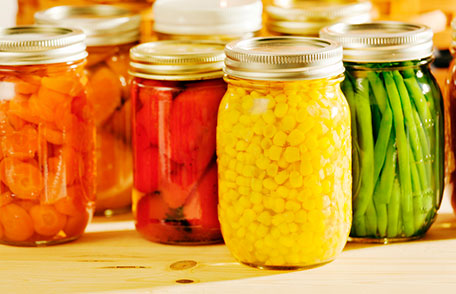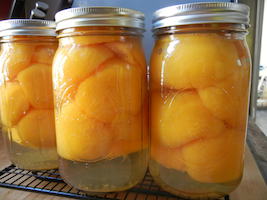It’s summertime and time to harvest the delicious produce you’ve been growing. You may be thinking about home canning as a way to preserve your garden goodies. But beware! If home canning is not done the proper way, your canned vegetables and fruits could cause botulism.
What is botulism?
Botulism is a rare but potentially deadly illness caused by a poison most commonly produced by a germ called Clostridium botulinum. The germ is found in soil and can survive, grow, and produce a toxin in certain conditions, such as when food is improperly canned. The toxin can affect your nerves, paralyze you, and even cause death.
You cannot see, smell, or taste botulinum toxin—but taking even a small taste of food containing this toxin can be deadly.
What are the symptoms of botulism?
Botulism is a medical emergency. If you or someone you know has symptoms of foodborne botulism, see your doctor or go to the emergency room immediately.
Symptoms may include the following:
- Double vision
- Blurred vision
- Drooping eyelids
- Slurred speech
- Difficulty swallowing
- A thick-feeling tongue
- Dry mouth
- Muscle weakness
How can I keep myself and others safe when it comes to home-canned foods?
Many cases of foodborne botulism have happened after people ate home-canned, preserved, or fermented foods that were contaminated with toxin. The foods became contaminated because they were not canned (processed) correctly.
You can take steps to protect yourself, your family, and others when it comes to home-canned foods by following these tips:
1. Use proper canning techniques.
The best way to prevent foodborne botulism is by carefully following instructions for safe home canning in the USDA Complete Guide to Home Canning. Do not follow recipes and cookbooks that do not follow the steps in the USDA guide, even if you got these items from a trusted friend or family member.
You can learn more about proper home canning from these resources:
- The National Center for Home Food Preservation
- State and county extension services (click on your state or scroll down for a list of all services)
2. Use the right equipment for the kind of foods that you are canning.
Pressure canning is the only recommended method for canning low-acid foods. Foods with low acid content are the most common sources of home-canning related botulism cases. Low-acids foods include almost every vegetable, some fruits, milk, all meats, fish, and seafood. See box to the right for examples. Do not use boiling water canners for low-acid foods because they will not protect against botulism.
Always use a properly sized pressure canner that meets USDA recommendations for pressure canning[3.61 MB] when canning low-acid foods. Contact your state or county extension service to find out if your pressure canner meets USDA recommendations.
Make your home-canned vegetables, meats safe
- Use a recommended pressure canner that holds at least four one-quart jars sitting upright on the rack.
- Be sure the gauge of the pressure canner is accurate. Gauges may be checked at many county Cooperative Extension offices or contact the pressure canner manufacturer for other options.
- Clean lid gaskets and other parts according to the manufacturer’s directions.
- Vent the pressure canner before pressurizing and follow recommended cooling steps.
- Use up-to-date process times and pressures for the kind of food, the size of jar, and the method of packing food in the jar.
3. When in doubt, throw it out!
If there is any doubt if safe canning guidelines have been followed, do not eat the food. Home-canned and store-bought food might be contaminated with toxin or other harmful germs if
- the container is leaking, bulging, or swollen;
- the container looks damaged, cracked, or abnormal;
- the container spurts liquid or foam when opened;
- the food is discolored, moldy, or smells bad.
If the container or the food inside has any signs of contamination, throw it out! If any of the food spills, wipe up the spill using a solution of 1/4 cup bleach for each 2 cups of water.
Never taste food to determine if it is safe. Do not taste or eat food that is discolored, moldy, or smells bad. Do not taste or eat food from cans that are leaking, have bulges or are swollen, or look damaged, cracked, or abnormal. Do not taste or eat food from a can that spurted liquid or foam when it was opened. Learn more >
 What’s a low-acid food?Low-acid foods have a pH level greater than 4.6, which means they are not acidic enough to prevent the growth of botulinum bacteria. Examples are:
What’s a low-acid food?Low-acid foods have a pH level greater than 4.6, which means they are not acidic enough to prevent the growth of botulinum bacteria. Examples are:
- Asparagus
- Green beans
- Beets
- Corn
- Potatoes
- Some tomatoes *
- Figs
- All meats
- Fish and seafood
*Tomatoes require added acid – lemon juice or citric acid – for safe home canning.
More Information
Home canning resources
- The National Center for Home Food Preservation
- State and county extension services (click on your state or scroll down for a list of all services)
- Temperatures for food preservation guide
- Processing times guide
Information about botulism
Scientific articles about botulism outbreaks
- Botulism outbreak from drinking prison-made illicit alcohol in a federal correctional facility—Mississippi, June 2016
- Large outbreak of botulism associated with a church potluck—Ohio, 2015
- Botulism associated with home-fermented tofu in two Chinese immigrants—New York City, March–April 2012
- Notes from the field: botulism from drinking prison-made illicit alcohol—Arizona, 2012.
- Three outbreaks of foodborne botulism caused by unsafe home canning of vegetables—Ohio and Washington, 2008 and 2009

